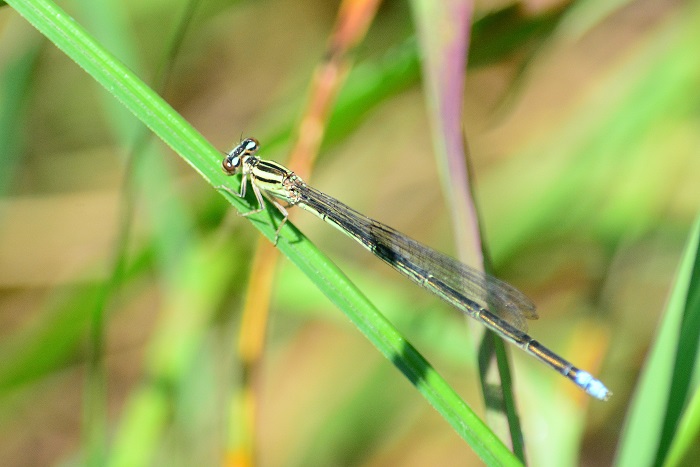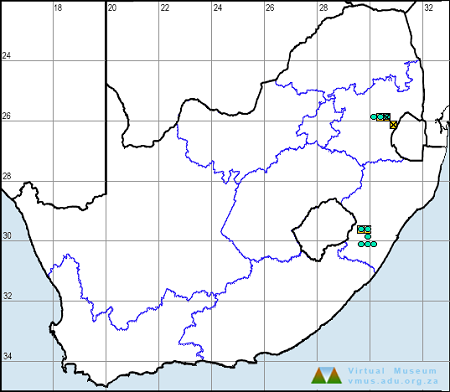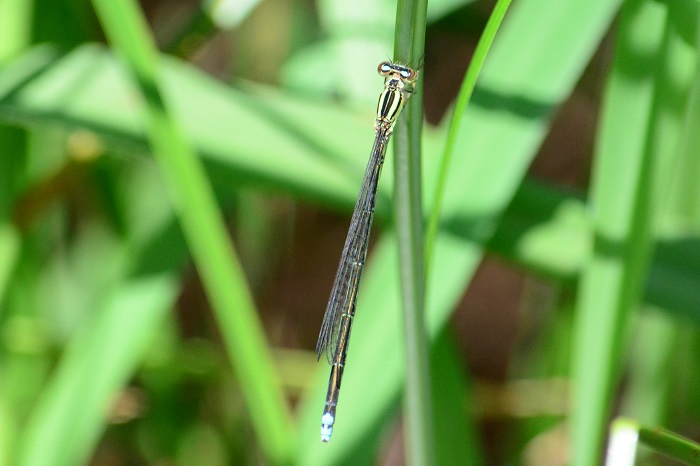Cover photo by Alan Manson.
Find the Balinsky’s Sprite in the FBIS database (Freshwater Biodiversity Information System) here.
Family Coenagrionidae
Identification

Komati River, Mpumalanga
Photo by Sharon Stanton
Small to medium sized
Length up to 42mm; Wingspan reaches 53mm.
Male Balinsky’s Sprites most resemble Pseudagrion spernatum (Upland Sprite) and Pseudagrion draconis (Mountain Sprite). The three species are similar. Balinsky’s Sprite males are readily differentiated from the Upland and Mountain Sprites as those species lack the purple-mauve terminal segments of Pseudagrion inopinatum.
Females are pale greenish-yellow and black. They show light blue postocular spots, a buff forehead and a pale blue labrum, the combination of which is diagnostic.
Click here for more details on identification.

uMkhomazi River, KwaZulu-Natal
Photo by Ryan Tippett
Habitat
Balinsky’s Sprite inhabits fast-flowing rivers and streams in mid-altitude areas around 1000m above sea level. It prefers rivers with emergent rocks and a rich growth of grasses or sedges along the banks.

Photo by Sharon Stanton
Behaviour
Balinsky’s Sprite perches on emergent and overhanging grass stems near fast-flowing water.
It is most active from early October until late March (see Phenology below).
Status and Conservation
Balinsky’s Sprite is a rare and localised endemic. It is listed as Near Threatened in the IUCN Red List of Threatened Species.
Distribution
Balinsky’s Sprite is endemic to South Africa, where it is highly localised. It is known from two widely separated areas, one around Badplaas and Machadodorp in Mpumalanga, and the other near Bulwer in the KwaZulu-Natal midlands.
Below is a map showing the distribution of records for Balinsky’s Sprite in the OdonataMAP database as at February 2020.

Below is a map showing the distribution of records for Balinsky’s Sprite in the OdonataMAP database as of December 2024.

The next map below is an imputed map, produced by an interpolation algorithm, which attempts to generate a full distribution map from the partial information in the map above. This map will be improved by the submission of records to the OdonataMAP section of the Virtual Museum.


Ultimately, we will produce a series of maps for all the odonata species in the region. The current algorithm is a new algorithm. The objective is mainly to produce “smoothed” maps that could go into a field guide for odonata. This basic version of the algorithm (as mapped above) does not make use of “explanatory variables” (e.g. altitude, terrain roughness, presence of freshwater — we will be producing maps that take these variables into account soon). Currently, it only makes use of the OdonataMAP records for the species being mapped, as well as all the other records of all other species. The basic maps are “optimistic” and will generally show ranges to be larger than what they probably are.
These maps use the data in the OdonataMAP section of the Virtual Museum, and also the database assembled by the previous JRS funded project, which was led by Professor Michael Samways and Dr KD Dijkstra.
Phenology



uMkhomazi River, KwaZulu-Natal
Photo by Ryan Tippett
Further Resources
The use of photographs by Alan Manson and Sharon Stanton is acknowledged. Other photographs by Ryan Tippett.
Balinsky’s Sprite Pseudagrion inopinatum Balinsky, 1971
Other common names: Badplaas Sprite (Alt. English); Balinsky-gesie (Afrikaans)
Recommended citation format: Loftie-Eaton M; Navarro R; Tippett RM; Underhill L. 2025. Balinsky’s Sprite Pseudagrion inopinatum. Biodiversity and Development Institute. Available online at https://thebdi.org/2020/05/19/balinskys-sprite-pseudagrion-inopinatum/
References: Tarboton, M; Tarboton, W. (2019). A Guide to the Dragonflies & Damselflies of South Africa. Struik Nature.
Samways, MJ. (2008). Dragonflies and Damselflies of South Africa. Pensoft
Samways, MJ. (2016). Manual of Freshwater Assessment for South Africa: Dragonfly Biotic Index. Suricata 2. South African National Biodiversity Institute, Pretoria

